肝局灶性结节增生(FNH)
FNH影像学诊断及鉴别诊断

无创影像学技术是指通过非侵入性的方式获取人体内部结构和功能信息的技术,如光学成 像、功能磁共振等。这些技术可以在不造成创伤的前提下实现对人体内部结构和功能的全 面检测。
提高影像学诊断准确率的建议
01
强化培训
提高影像学医生的诊断水平需要不断加强培训,使其掌握最新的影像
学技术和诊断方法。
声和多排螺旋CT可以更准确地诊断FNH。
03
fnh影像学诊断标准及流程
诊断标准
01
明确病变部位、大小、形态及毗邻关系,分析病变成分及其与周围组织的关系 。
02
确定病变性质:FNH是肝脏局灶性结节增生,属于良性病变,需与肝癌、肝转 移癌等恶性肿瘤相鉴别。
03
鉴别诊断:结合病史、临床表现及影像学检查,排除肝癌、肝转移癌等恶性肿 瘤,同时与其他良性病变如肝腺瘤、肝血管瘤等鉴别。
06
展望
fnh影像学技术的发展趋势
人工智能辅助诊断
随着深度学习和大数据分析技术的发展,人工智能辅助诊断技术已经成为影像学领域的研 究热点。通过人工智能技术,可以实现对影像学数据的自动分析和诊断,提高诊断准确率 和效率。
多模态影像学技术
随着医学影像学技术的发展,多模态影像学技术已经成为一个新的趋势。通过将多种影像 学技术(如超声、核磁、CT等)结合起来,可以获得更全面的影像学信息,提高诊断准确 率。
Hale Waihona Puke 02多学科联合通过多学科联合,将多个领域的专家和医生集合起来,共同进行疾病
的诊断和治疗,可以提高诊断准确率和治疗效果。
03
标准化和规范化
建立统一的影像学诊断标准和规范,可以使不同医生之间的诊断结果
具有可比性,提高诊断准确率。
肝脏局灶性结节样增生28例的超声诊断要素探索

肝脏局灶性结节样增生28例的超声诊断要素探索
肝脏局灶性结节样增生(FNH)是一种良性病变,常见于女性。
FNH表现为局限性肝脏结节样增生,绝大多数时无症状。
然而,在一些情况下,肝脏FNH的确诊需要多种影像学和病理学检查。
其中超声是最常用的一种方法,具有无创、重复性好和安全的特点,并可提供诸如病变大小、形态、内部结构、血流情况等方面的信息,为FNH的诊断提供了重要的帮助。
本文旨在探讨肝脏FNH的超声诊断要素,以提高其诊断准确性。
一、病变大小
FNH的大小常见于1~5 cm或更大,因此,超声检查时应注意扫描肝脏全面,尤其是肝右叶后段。
此外,还要计算病变的最大径和横纵比,以便与其他肝脏病变相区分。
二、形态
FNH多呈圆形或卵圆形,少数为不规则形或分叶状。
因此,在超声检查时应注意病变形态、轮廓是否规则,有无分叶、毛刺等。
三、内部结构
FNH的内部结构常见为均匀回声或低回声,也可能有不均匀回声或高回声。
此外,FNH 内有1%~33%的病变可见包涵体,这些包涵体呈“毛玻璃状”、散在分布。
因此,在超声检查时应注意病变内回声的分布情况、回声强度和是否存在包涵体。
四、边缘
FNH与假包膜紧密相连,边缘清晰锐利。
因此,在超声检查时应注意病变与周围肝组织的分界清晰度和有无假包膜。
五、血流
FNH血流主要来源于动脉,常见于肝脏的周边部位。
因此,在超声检查过程中应用彩色多普勒血流成像、脉冲多普勒血流谱图等方法检测病变的血流情况。
正常情况下,FNH 的血流呈强度不等的、周边性的、分叶状血流灌注模式,较为显著。
FNH一般无门静脉显影。
肝局灶性结节增生FNH和肝腺瘤的影像诊断与鉴别诊断

瘢痕内有厚壁供血动脉,但无门脉血液。 • 病灶中心的“星形瘢痕”并非真性瘢痕,而是血
管与胆管的聚积。
病理分型
经典型:最为常见(80%),呈结节型,切面具有典型特征性改变,即病变中央有星形瘢痕;病 灶周边或中央存在供血血管。
• 孤立结节样增生实质,被环形纤维间隔完全或不 完全包绕
M-31Y CT体检发现肝占位
M-20Y 体检发现肝占位
M-20Y 体检发现肝占位
临床特点 CT MRI
强化特点 包膜
中央低密度
小结
FNH
HCA
常见 好发年轻女性 雌激素刺激血管畸形发展
罕见 好发年轻女性 与服用避孕药有关
等或稍低密度
等或稍低密度
信号常较均匀
信号常不均匀
快进慢出
快进慢出/快进快出
及早手术切除 • 镜下肿瘤主要由肝细胞组成,但肝细胞的排列不具有正常肝小叶结构,
而是杂乱无章,结构内无胆管,病灶容易出血,肿瘤实质内可见脂肪
影像学表现
CT
• 平扫密度与正常肝实质接近或略低,边缘清晰,有完整包膜,无中央瘢痕 • 可有出血、坏死、脂肪变性 • 动脉期病灶明显不均匀强化 • 静脉期病灶密度下降,呈等密度或略低密度 • 延迟扫描病灶逐渐变为低密度 • 如病灶中心有出血,其中心低密度不强化 • 部分病例整个增强过程始终呈低密度
• 中央疤痕包含纤维结缔组织、增生的胆管及周围 浸润的炎症细胞以及各种畸形的血管,畸形的中 央动脉呈离心状向外供血。
病理分型
不典型:病变中央缺乏星形瘢痕灶,或畸形血管,但都有胆管增生。
可分为以下3型: 1毛细血管扩张型:表现为短小的纤维分隔+较多的扩张 血管+小胆管增生。 2混合细胞型:少许纤维间隔+少数畸形血管,肝细胞实 质性增生及增生的胆管明显。 3伴肝细胞不典型增生型:可具有上述不同类型成分的 表现。
肝脏局灶性结节样增生28例的超声诊断要素探索

肝脏局灶性结节样增生28例的超声诊断要素探索肝脏局灶性结节样增生(FNH)是一种较常见的肝脏良性病变,其病理学特征为以肝细胞增生为主,周围有纤维或弹力纤维包绕形成假包膜,通常单发、大小多在5cm以内,多无自发破裂出血等严重并发症。
由于FNH无恶性潜能,因此对于其的早期发现和诊断显得尤为重要。
近年来,随着超声技术的不断发展,其在FNH诊断方面已经取得了显著的进展。
本文就超声诊断肝脏FNH的要素进行探索,以期对临床更精准的判断和治疗提供参考。
1. 形态特征FNH的形态特征较为典型,多呈一个近于圆形的结节状影像,直径一般在5cm以内,常位于肝脏右叶的后上部或前下部,亦可见于左叶。
超声图像中,FNH通常为高回声,呈欠均匀的假包膜下低回声,边缘光整,常有血管穿行,且血管呈'半圆'或'鱼钩'状。
FNH有时伴有毛刺状锐角或血管抽象,这些特征对于进一步确认病变的良恶性十分有帮助。
2. 血液灌注FNH的特征性血液供应是进行诊断的重要指标。
多数情况下,FNH的血供表现为异位性动脉供血,即病变内的血管与周围肝组织无直接分支关系。
超声检查可通过彩色多普勒测量病变内血管的血流速度、流量、充盈时间等指标,发现局限性的、特征性的、大量的血流供应,而周围健康肝组织血流情况无循环淤滞的迹象。
此外,对于血管囊性扩张病人,在超声引导下可进行局部静脉注射造影剂以更明确地显示病变的血流特征。
3. 弹性成像弹性成像技术近年来已广泛应用于FNH的诊断中,其能够定量地测量病变组织的硬度和弹性,有助于准确分析病变的组织学和功能学信息。
常见的弹性成像技术包括声速弹性成像、切向弹性成像等。
声速弹性成像可将组织的声波传播速度与硬度联系起来,通过对声波传播过程中声波反射和折射的分析,计算出病变与周围健康组织的声速比值,发现FNH的声速比值通常高于0.9,其硬度与正常肝组织接近;而恶性肝瘤的声速比值通常在0.5-0.9之间,且硬度明显高于正常肝组织。
肝局灶性结节增生的影像PPT课件

肝转移瘤的病灶内可出现钙化或出血,而肝局灶性结节增生的病灶内 则较少出现钙化或出血。
05
CATALOGUE
肝局灶性结节增生的治疗与预后
药物治疗
常用的药物包括化疗药物、靶向药物和免疫治 疗药物等,具体药物选择需要根据患者的病情
和身体状况进行个体化评估。
药物治疗的缺点在于可能会产生副作用,如恶心、呕 吐、乏力等,需要密切监测并及时处理。
通过高频超声探头,可以清晰 显示肝脏的形态、大小、回声 以及血流情况,有助于发现肝 脏内的局灶性病变。
超声检查对于鉴别良恶性病变 具有一定的价值,但准确率相 对较低。
CT检查
CT检查是肝局灶性结节增生的 常用影像学检查方法之一,具有
较高的分辨率和准确性。
通过多层螺旋CT扫描,可以清 晰显示肝脏的解剖结构和病灶的 形态、大小、密度等信息,有助
药物治疗是肝局灶性结节增生的首选治疗方法 ,主要通过口服或注射药物来抑制肿瘤生长和 扩散。
药物治疗的优点在于可以在一定程度上控制肿瘤 生长,延长患者生存期,提高生活质量。
手术治疗
对于某些肝局灶性结节增生患者,手术切除是最佳的治 疗方法。
手术治疗的优点在于可以彻底切除肿瘤,降低复发风险 ,提高治愈率。
超声影像学表现
01
02
03
高分辨率超声表现
显示肝脏局部结节或肿块 ,边界清晰,形态规则或 不规则。
彩色多普勒超声
显示结节内部及周边血流 情况,有助于判断结节性 质。
超声造影
通过观察结节造影剂灌注 和消退特点,有助于鉴别 良恶性病变。
CT影像学表现
平扫CT
显示低密度或等密度结节 ,边界清晰或不清晰。
THANKS
感谢观看
磁共振成像在FNH诊断中的应用

磁共振成像在FNH诊断中的应用在肝疾病的诊断中,我作为一名经验丰富的医生,越来越依赖磁共振成像技术。
尤其是面对肝内占位性病变,如肝血管瘤、肝细胞癌、转移性肝癌以及肝内良性肿瘤等,磁共振成像(MRI)已成为我最得力的。
今天,我想分享一下磁共振成像在肝内良性肿瘤,即肝局灶性结节性增生的诊断中的应用。
肝局灶性结节性增生(FNH)是一种少见的肝良性肿瘤,但其临床表现和生物学行为与肝细胞癌相似,因此,准确诊断对于制定治疗方案和评估患者预后至关重要。
在FNH的诊断中,磁共振成像发挥了重要作用。
磁共振成像具有高软组织分辨率,能够清晰显示肝脏的解剖结构和病灶的性质。
通过不同的序列和脉冲序列,磁共振成像可以提供丰富的信息,有助于区分FNH与其他肝内病变。
在FNH的磁共振成像表现中,最常见的特点是病灶的“亮周边”现象,即病灶周边的磁场强度高于病灶内部。
这是由于FNH病灶内部的胶原纤维含量较高,使得水分子的运动受限,导致T2加权像上信号减低。
而病灶周边的纤维包膜较薄,水分子的运动受限较轻,因此在T2加权像上信号较高。
除了“亮周边”现象,FNH在磁共振成像上还可以表现为均匀增强。
这是由于FNH病灶内部的血管丰富,对比剂能够迅速进入病灶,并在成像过程中保持较高的信号强度。
下面,我想分享一个实际的案例,以说明磁共振成像在FNH诊断中的应用。
患者,女性,50岁,因“体检发现肝占位”就诊。
患者无明显不适,实验室检查肝功能正常。
腹部超声检查发现肝右叶一个约4cm的占位性病变。
考虑到病灶的性质待定,建议患者进行磁共振成像检查。
磁共振成像显示,肝右叶病灶呈圆形,边缘清晰,具有“亮周边”现象。
在动态增强扫描中,病灶在动脉期明显增强,并在延迟期持续保持较高信号。
根据磁共振成像表现,结合患者的临床资料,诊断倾向于肝局灶性结节性增生。
最终,患者接受了肝脏穿刺活检,病理结果显示为肝局灶性结节性增生。
根据患者的病情,我们制定了随访观察的治疗方案。
肝脏局灶性结节性增生的诊断与治疗
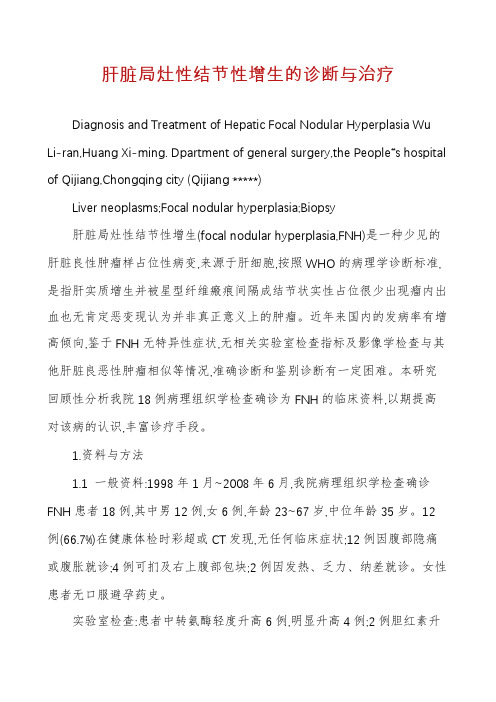
肝脏局灶性结节性增生的诊断与治疗Diagnosis and Treatment of Hepatic Focal Nodular Hyperplasia WuLi-ran,Huang Xi-ming. Dpartment of general surgery,the People“s hospital of Qijiang,Chongqing city (Qijiang *****)Liver neoplasms;Focal nodular hyperplasia;Biopsy肝脏局灶性结节性增生(focal nodular hyperplasia,FNH)是一种少见的肝脏良性肿瘤样占位性病变,来源于肝细胞,按照WHO的病理学诊断标准,是指肝实质增生并被星型纤维瘢痕间隔成结节状实性占位很少出现瘤内出血也无肯定恶变现认为并非真正意义上的肿瘤。
近年来国内的发病率有增高倾向,鉴于FNH无特异性症状,无相关实验室检查指标及影像学检查与其他肝脏良恶性肿瘤相似等情况,准确诊断和鉴别诊断有一定困难。
本研究回顾性分析我院18例病理组织学检查确诊为FNH的临床资料,以期提高对该病的认识,丰富诊疗手段。
1.资料与方法1.1 一般资料:1998年1月~2008年6月,我院病理组织学检查确诊FNH患者18例,其中男12例,女6例,年龄23~67岁,中位年龄35岁。
12例(66.7%)在健康体检时彩超或CT发现,无任何临床症状;12例因腹部隐痛或腹胀就诊;4例可扪及右上腹部包块;2例因发热、乏力、纳差就诊。
女性患者无口服避孕药史。
实验室检查:患者中转氨酶轻度升高6例,明显升高4例;2例胆红素升高;2例甲胎蛋白轻度升高(42ng/ml),但肝功能均为Child-pugh A级,凝血酶原时间正常。
HBsAg阳性3例,丙型肝炎抗体阳性1例。
影像学检查:B超检查3例疑为肝癌,3例诊断为肝内占位性质未明,1例疑为肝血管瘤,11例诊断为FNH。
安徽放射科模拟题2021年(44)_真题-无答案
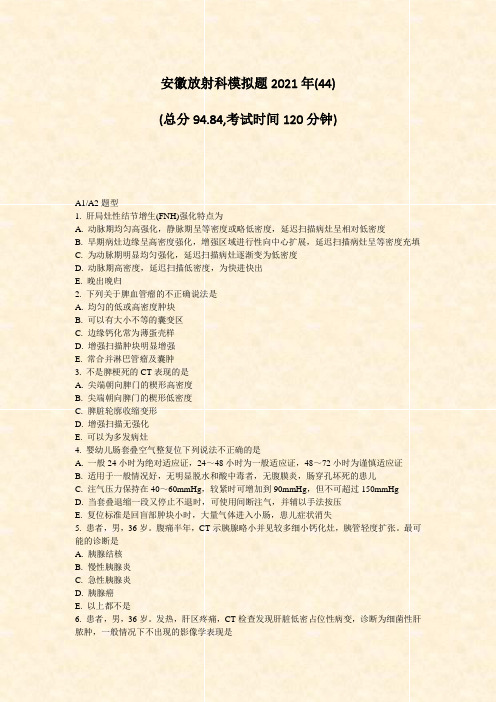
安徽放射科模拟题2021年(44)(总分94.84,考试时间120分钟)A1/A2题型1. 肝局灶性结节增生(FNH)强化特点为A. 动脉期均匀高强化,静脉期呈等密度或略低密度,延迟扫描病灶呈相对低密度B. 早期病灶边缘呈高密度强化,增强区域进行性向中心扩展,延迟扫描病灶呈等密度充填C. 为动脉期明显均匀强化,延迟扫描病灶逐渐变为低密度D. 动脉期高密度,延迟扫描低密度,为快进快出E. 晚出晚归2. 下列关于脾血管瘤的不正确说法是A. 均匀的低或高密度肿块B. 可以有大小不等的囊变区C. 边缘钙化常为薄蛋壳样D. 增强扫描肿块明显增强E. 常合并淋巴管瘤及囊肿3. 不是脾梗死的CT表现的是A. 尖端朝向脾门的楔形高密度B. 尖端朝向脾门的楔形低密度C. 脾脏轮廓收缩变形D. 增强扫描无强化E. 可以为多发病灶4. 婴幼儿肠套叠空气整复位下列说法不正确的是A. 一般24小时为绝对适应证,24~48小时为一般适应证,48~72小时为谨慎适应证B. 适用于一般情况好,无明显脱水和酸中毒者,无腹膜炎,肠穿孔坏死的患儿C. 注气压力保持在40~60mmHg,较紧时可增加到90mmHg,但不可超过150mmHgD. 当套叠退缩一段又停止不退时,可使用间断注气,并辅以手法按压E. 复位标准是回盲部肿块小时,大量气体进入小肠,患儿症状消失5. 患者,男,36岁。
腹痛半年,CT示胰腺略小并见较多细小钙化灶,胰管轻度扩张。
最可能的诊断是A. 胰腺结核B. 慢性胰腺炎C. 急性胰腺炎D. 胰腺癌E. 以上都不是6. 患者,男,36岁。
发热,肝区疼痛,CT检查发现肝脏低密占位性病变,诊断为细菌性肝脓肿,一般情况下不出现的影像学表现是A. 平扫示低密度占位,中心区CT值略高于水B. 多为圆形或椭圆形,部分腔内有分隔C. 多数病灶边缘不清楚D. 脓肿周围出现不同密度环征E. 增强扫描脓肿壁无强化7. 在正常腹平片上见不到的软组织影是A. 肝脏B. 肾脏C. 膈D. 腰大肌E. 肾上腺8. 下列不属于胃溃疡演变的是A. 恶变B. 线状溃疡C. 胼胝溃疡D. 穿孔E. 穿透性溃疡9. 溃疡型肠结核的X线征象不正确的是A. 有肠管张力增高B. 管腔挛缩C. 激惹D. 管腔边缘呈锯齿状E. 充盈缺损10. 患者,男,60岁。
肝局灶性结节性增生FNH诊疗常规样本
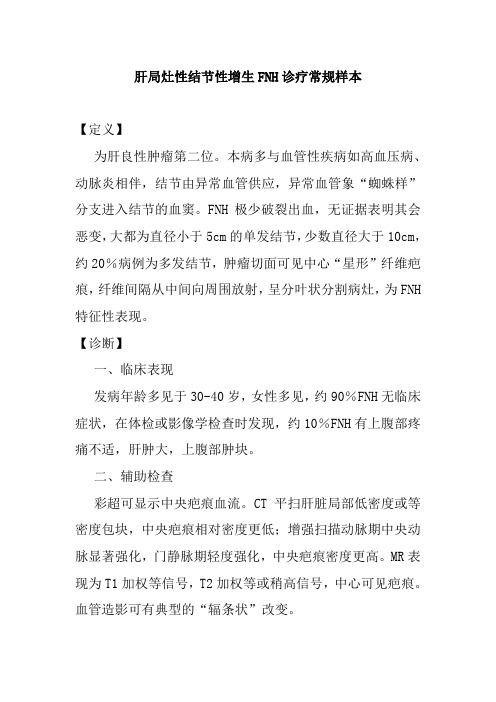
肝局灶性结节性增生FNH诊疗常规样本
【定义】
为肝良性肿瘤第二位。
本病多与血管性疾病如高血压病、动脉炎相伴,结节由异常血管供应,异常血管象“蜘蛛样”分支进入结节的血窦。
FNH极少破裂出血,无证据表明其会恶变,大都为直径小于5cm的单发结节,少数直径大于10cm,约20%病例为多发结节,肿瘤切面可见中心“星形”纤维疤痕,纤维间隔从中间向周围放射,呈分叶状分割病灶,为FNH 特征性表现。
【诊断】
一、临床表现
发病年龄多见于30-40岁,女性多见,约90%FNH无临床症状,在体检或影像学检查时发现,约10%FNH有上腹部疼痛不适,肝肿大,上腹部肿块。
二、辅助检查
彩超可显示中央疤痕血流。
CT平扫肝脏局部低密度或等密度包块,中央疤痕相对密度更低;增强扫描动脉期中央动脉显著强化,门静脉期轻度强化,中央疤痕密度更高。
MR表现为T1加权等信号,T2加权等或稍高信号,中心可见疤痕。
血管造影可有典型的“辐条状”改变。
三、鉴别诊断
主要与肝细胞腺瘤、肝细胞癌鉴别。
【治疗】
无症状的FNH可以观察,定期随访。
不能明确诊断,无法排除肝细胞腺癌及肝细胞腺瘤的应积极手术治疗。
肝结节mr分类标准

肝结节mr分类标准
肝结节的MR分类标准如下:
1. 肝血管瘤:由于肝血管瘤内缺乏肝脏细胞,使用肝细胞特异的对比剂,肝血管瘤在肝胆期呈低信号。
血管瘤是常见的良性病变,T2中高信号,边缘结节状不连续的强化、对比剂滞留都是提示血管瘤的证据。
2. 局灶结节性增生(FNH):FNH为肝细胞不规则增生,可伴中心坏死,好发于年轻女性。
MR诊断FN准确率较高。
平扫很难区分含肝细胞的FNH 与正常肝组织,T1WI呈等信号,T2WI可轻度高信号。
中心的坏死T1WI 可为低信号,T2WI为中高信号。
增强后,动脉期为均匀强化,门脉期与肝实质等信号,中心坏死可见延迟强化。
FNH不出现对比剂快速流出(washout)。
3. 肝硬化:肝硬化可分为小结节型、大结节型和混合型。
再生结节的大小和脂肪变性程度不同,MRI表现也有所不同。
4. 脂肪肝:脂肪肝的MRI表现包括SE和IR的T1WI呈正常信号,STIR序列和SE的T2WI信号可稍有增高,血管结构没有明显改变。
以上信息仅供参考,如有疑问或症状,请及时前往医院,寻求专业医生的帮助。
肝局灶性结节增生的影像

Mathieu D, et al., Magn Reson Imaging Clin N Am,1977,5: 255-288 Nyuyen BN, et al., Am J Surg Pathol,1999,23:1441-1454
分类 (Classification)
• 典型性(Classic) 80%
Naugen BN, et al. Am J Surg Pathol, 1999,23: 1441-1454
组织结构 (Architecture)
• 1, 典型型 (a) 异常的结节组织学构筑(Abnormal nodular architecture) (b) 畸形血管 (Malformed vessels) (c) 增殖的胆管 (Cholangiolar proliferation)
病变
T2WI 等, 略高 高 高 高 高 高
中心疤痕
T1WI 低 低 低 低 低 低 T2WI 高 高 低 低 低 高
动脉增强 HAP 病变 中心疤痕 包膜 +++ - +- + ++ +++ ++ PVP DP
SPIO
ECT
+
+
Chaoui A, et al., AJR, 1998,171: 1433-1434 Mclarney JK, et al., RadioGraphics, 1999,19: 453-471
• 1. 典型的FNH A. 大体病理(Gross inspection): a) 肿块由分叶的结节构成; b) 由肿块中心疤痕(Central Scar)向四周呈辐射 的纤维间隔将肿块隔开;
c) 疤痕中含有畸形血管 d) 绝大多数病例病变有一个或一个以上的中心 疤痕
• B. 镜下(Microscopic findings): a) 结节增生组织,结节由环形或间断的纤维 间隔(Fibrous Septa) 完全或不完全环绕。由正 常肝细胞组成的肝板可呈中等程度增厚。
肝局灶性结节性增生的超声表现

28
2019.03 No.8
文/ 张心怡(江苏省中医院超声医学科)
肝局灶性结节性增生(FNH)是肝脏较少见的良性肿瘤样病变,可发生于任何年龄段,多见于20~50岁,男女发病率国内外报道不一致,少数儿童也可发病。
一般无明显临床症状及体征,故多于体检或因其他疾病就诊时偶然发现。
少数患者可表现为右上腹不适、腹部包块或因瘤体过大出现临近器官压迫症状而就诊。
实验室检查一般并无任何特殊,个别病例可因其肿块压迫肝胆管,可引起肝功能异常,但甲胎蛋白、CA199等肿瘤标志物指标为阴性,这可与肝细胞癌等恶性病变相鉴别。
肝局灶性结节性增生在常规灰阶超声上常表现较隐匿,与周围肝组织回声分界不清,有时主要依靠其对周围管道的推挤移位或病灶周围出现暗环等继发性特征图1图4图2图5图3
条状低回声
放射状血流声
后方回声稍增强
稍低回声病灶。
肝局灶性结节性增生影像表现

经典者中央或偏心瘢痕在T1WI 和T2WI分别为低信号和高信号, 不经典者T2WI上可体现为低信 号等。
T1W
T2W
增强:
动脉期: 病灶明显 均匀强化, 中心瘢痕 无明显强 化
门脉及实质 期:病灶内 趋向呈等信 号,中心瘢 痕强化
边沿
向中
心强
化
有假包膜
可有纤维性包膜
无包膜
可有纤维性包膜
FNH旳假包膜
FNH是没有纤维包膜旳,但是有假包膜。
FNH压迫周围正常旳肝实 质
周围旳血管
假包膜
炎性旳反应
因为FNH旳假包膜为压迫周围正常 组织以及某些灶周血管和炎性侵润
所以在CT上为较低密度;在MR旳 T2W上为高信号,而且能够有延迟 强化
门脉期:病灶 实质强化部分 造影剂开始迅 速退出,趋向 等密度 。
延迟期呈 等密度, 中心瘢痕 轻度强化
FNH周围可 见血管影,这 与肿瘤周围扩 大旳血管、血 窦有关。另外 有人认FNH 是一种先天性 血管畸形,动 脉血流灌注增 长造成肝细胞 增生。在动脉 期扫描经常能 显示异常动脉。
平扫: FNH旳MR体现:
肝局灶性结节性增生 影像表现
基本简介
在肝脏良性占位性病变中FNH发病率仅次 于海绵状血管瘤。
发病原因至今未明,血管畸形和血管性损伤 可能为其潜在旳机制。
男、女任何年龄均可发病,但最佳发于年轻 女性。临床上一般无症状,多数偶尔发觉。
FNH比肝腺瘤更常见,约为腺瘤旳2倍,与 服避孕药无明显关系,但是可能服避孕药会 造成其增大。
超顺磁性氧化铁
造影后实质部分
信号降低,而疤
肝局灶性结节增生的MRI临床诊断的探讨
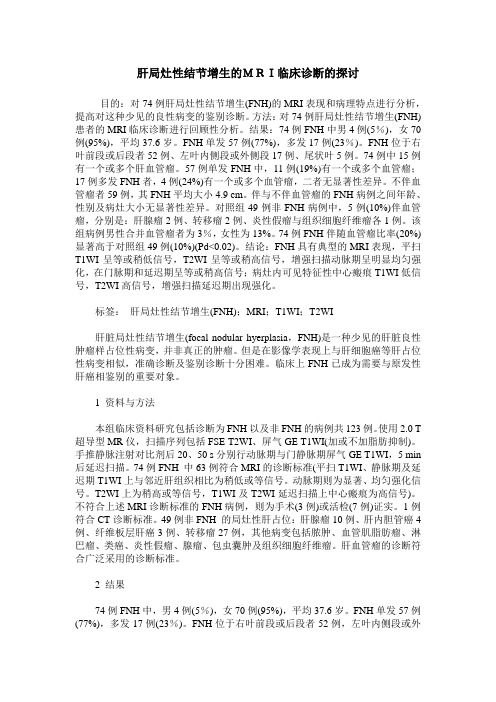
肝局灶性结节增生的MRI临床诊断的探讨目的:对74例肝局灶性结节增生(FNH)的MRI表现和病理特点进行分析,提高对这种少见的良性病变的鉴别诊断。
方法:对74例肝局灶性结节增生(FNH)患者的MRI临床诊断进行回顾性分析。
结果:74例FNH中男4例(5%),女70例(95%),平均37.6岁。
FNH单发57例(77%),多发17例(23%)。
FNH位于右叶前段或后段者52例、左叶内侧段或外侧段17例、尾状叶5例。
74例中15例有一个或多个肝血管瘤。
57例单发FNH中,11例(19%)有一个或多个血管瘤;17例多发FNH者,4例(24%)有一个或多个血管瘤,二者无显著性差异。
不伴血管瘤者59例,其FNH平均大小4.9 cm。
伴与不伴血管瘤的FNH病例之间年龄、性别及病灶大小无显著性差异。
对照组49例非FNH病例中,5例(10%)伴血管瘤,分别是:肝腺瘤2例、转移瘤2例、炎性假瘤与组织细胞纤维瘤各1例。
该组病例男性合并血管瘤者为3%,女性为13%。
74例FNH伴随血管瘤比率(20%)显著高于对照组49例(10%)(Pd<0.02)。
结论:FNH具有典型的MRI表现,平扫T1WI呈等或稍低信号,T2WI呈等或稍高信号,增强扫描动脉期呈明显均匀强化,在门脉期和延迟期呈等或稍高信号;病灶内可见特征性中心瘢痕T1WI低信号,T2WI高信号,增强扫描延迟期出现强化。
标签:肝局灶性结节增生(FNH);MRI;T1WI;T2WI肝脏局灶性结节增生(focal nodular hyerplasia,FNH)是一种少见的肝脏良性肿瘤样占位性病变,并非真正的肿瘤。
但是在影像学表现上与肝细胞癌等肝占位性病变相似,准确诊断及鉴别诊断十分困难。
临床上FNH已成为需要与原发性肝癌相鉴别的重要对象。
1 资料与方法本组临床资料研究包括诊断为FNH以及非FNH的病例共123例。
使用2.0 T 超导型MR仪,扫描序列包括FSE T2WI、屏气GE T1WI(加或不加脂肪抑制)。
肝脏局灶性结节增生(FNH)CT诊断与鉴别
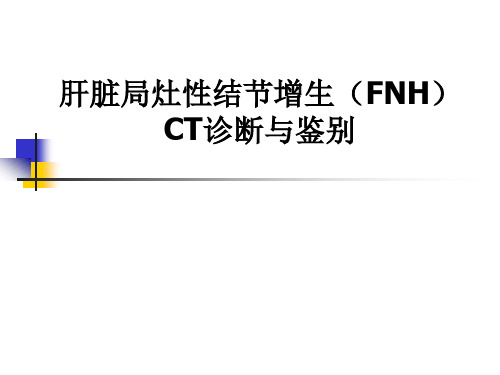
A1 无中央疤痕结构的FNH
A2:无中央疤痕结构的FNH
2、动脉、门脉和延迟期为高密度FNH
原因:1、脂肪肝背景; 2、病灶位于肝脏上部,动脉、门脉
期扫描时病灶所在层面的血流属于肝动 脉后期相,因而病灶强化仍明显。
B1:平扫、动脉、门脉和延迟期为高密 度FNH
B2:动脉、门脉和延迟期为高密度FNH
CT或MRI能显示病灶中存在的疤痕结 构。
典型FNH的CT影像特征表现
1、CT平扫:病灶为等或稍低密度, 中央疤痕结构密度更低;
CT多期增强:
ቤተ መጻሕፍቲ ባይዱ1)动脉期~除中央疤痕病灶全瘤样强化, 其密度明显高于肝实质并接近同层腹主动 脉;
2)门脉期~病灶强化程度下降,为等或稍 高密度,中央疤痕仍为低密度;
3)延迟期~病灶为等或稍低,疤痕结构在 延迟时可出现强化,由低密度变成高或等 密度。
疤痕呈放射状或车辐状
低倍镜下肿块显示中心纤维疤痕组织,肝组织被粗实 纤维组织分隔,形成多个小结节
纤维间隔内含管壁粗厚的动脉、静脉
可见标本内增生的胆管
组成肿块的肝细胞肥大,无血管侵润, 未见核分裂象。
二、典型FNH的影像表现
典型FNH:所谓典型即病灶强化符合 -----“快进、缓退、瘢痕延迟强化” 的特殊性;
病例1
病例2
病例3
病例4
病例5
FNH供血动脉由病灶中心向周围辐射状分布
中心星芒状疤痕以及放射 中心星芒状疤痕延迟强化
状分布的滋养动脉
后缩小
与前同一病例,DSA显示FNH 有一条供血动脉
。 由病灶中心向周围辐射状分布
CTA显示供血动脉
二、FNH的一些特殊影像表现
1、无中央疤痕结构的FNH 原因:病理组织学上FNH均存在中央疤痕, 当病灶本身较小时,则中央疤痕结构更小, 且密度或信号差异小,故不易在CT和MRI 上显示;实际疤痕结构显示率为30%左右。
这下你了解肝脏局灶性结节性增生(FNH)了吗?
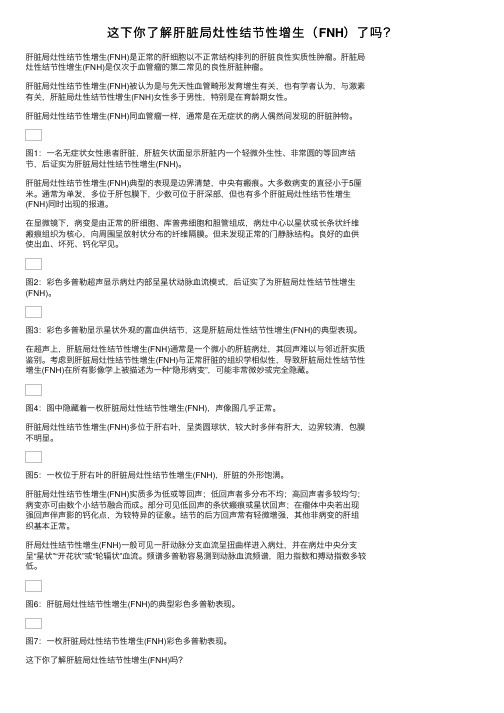
这下你了解肝脏局灶性结节性增⽣(FNH)了吗?肝脏局灶性结节性增⽣(FNH)是正常的肝细胞以不正常结构排列的肝脏良性实质性肿瘤。
肝脏局灶性结节性增⽣(FNH)是仅次于⾎管瘤的第⼆常见的良性肝脏肿瘤。
肝脏局灶性结节性增⽣(FNH)被认为是与先天性⾎管畸形发育增⽣有关,也有学者认为,与激素有关,肝脏局灶性结节性增⽣(FNH)⼥性多于男性,特别是在育龄期⼥性。
肝脏局灶性结节性增⽣(FNH)同⾎管瘤⼀样,通常是在⽆症状的病⼈偶然间发现的肝脏肿物。
图1:⼀名⽆症状⼥性患者肝脏,肝脏⽮状⾯显⽰肝脏内⼀个轻微外⽣性、⾮常圆的等回声结节,后证实为肝脏局灶性结节性增⽣(FNH)。
肝脏局灶性结节性增⽣(FNH)典型的表现是边界清楚,中央有瘢痕。
⼤多数病变的直径⼩于5厘⽶。
通常为单发,多位于肝包膜下,少数可位于肝深部,但也有多个肝脏局灶性结节性增⽣(FNH)同时出现的报道。
在显微镜下,病变是由正常的肝细胞、库普弗细胞和胆管组成,病灶中⼼以星状或长条状纤维瘢痕组织为核⼼,向周围呈放射状分布的纤维隔膜。
但未发现正常的门静脉结构。
良好的⾎供使出⾎、坏死、钙化罕见。
图2:彩⾊多普勒超声显⽰病灶内部呈星状动脉⾎流模式,后证实了为肝脏局灶性结节性增⽣(FNH)。
图3:彩⾊多普勒显⽰星状外观的富⾎供结节,这是肝脏局灶性结节性增⽣(FNH)的典型表现。
在超声上,肝脏局灶性结节性增⽣(FNH)通常是⼀个微⼩的肝脏病灶,其回声难以与邻近肝实质鉴别。
考虑到肝脏局灶性结节性增⽣(FNH)与正常肝脏的组织学相似性,导致肝脏局灶性结节性增⽣(FNH)在所有影像学上被描述为⼀种“隐形病变”,可能⾮常微妙或完全隐藏。
图4:图中隐藏着⼀枚肝脏局灶性结节性增⽣(FNH),声像图⼏乎正常。
肝脏局灶性结节性增⽣(FNH)多位于肝右叶,呈类圆球状,较⼤时多伴有肝⼤,边界较清,包膜不明显。
图5:⼀枚位于肝右叶的肝脏局灶性结节性增⽣(FNH),肝脏的外形饱满。
肝脏局灶性结节性增⽣(FNH)实质多为低或等回声;低回声者多分布不均;⾼回声者多较均匀;病变亦可由数个⼩结节融合⽽成。
肝脏局灶性结节样增生( FNH )的影像学表现及鉴别诊断
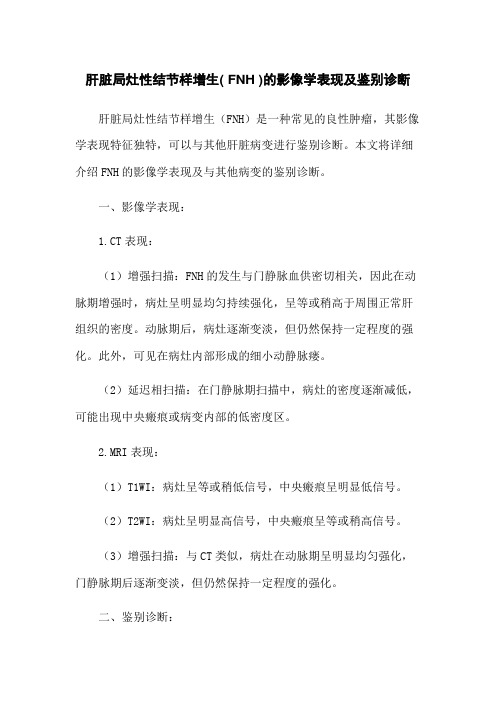
肝脏局灶性结节样增生( FNH )的影像学表现及鉴别诊断肝脏局灶性结节样增生(FNH)是一种常见的良性肿瘤,其影像学表现特征独特,可以与其他肝脏病变进行鉴别诊断。
本文将详细介绍FNH的影像学表现及与其他病变的鉴别诊断。
一、影像学表现:
1.CT表现:
(1)增强扫描:FNH的发生与门静脉血供密切相关,因此在动脉期增强时,病灶呈明显均匀持续强化,呈等或稍高于周围正常肝组织的密度。
动脉期后,病灶逐渐变淡,但仍然保持一定程度的强化。
此外,可见在病灶内部形成的细小动静脉瘘。
(2)延迟相扫描:在门静脉期扫描中,病灶的密度逐渐减低,可能出现中央瘢痕或病变内部的低密度区。
2.MRI表现:
(1)T1WI:病灶呈等或稍低信号,中央瘢痕呈明显低信号。
(2)T2WI:病灶呈明显高信号,中央瘢痕呈等或稍高信号。
(3)增强扫描:与CT类似,病灶在动脉期呈明显均匀强化,门静脉期后逐渐变淡,但仍然保持一定程度的强化。
二、鉴别诊断:
1.肝细胞瘤(HCC):FNH和HCC在影像学上有一些相似之处,
但两者的强化方式和内部构成不同。
FNH的强化程度较低且均匀持续,而HCC的强化程度较高,且可见坏死灶、出血或囊变等特征。
2.肝血管瘤:肝血管瘤在动脉期呈明显强化,但门静脉期几乎
完全减弱。
与FNH相比,肝血管瘤的强化程度更高。
3.肝转移瘤:肝转移瘤在CT和MRI上表现为多发或单发的病灶,其边界模糊,强化方式与FNH不同,常伴有肝外转移灶。
附件:
本文档未涉及附件。
法律名词及注释:
无。
肝脏局灶性结节增生(FNH)CT诊断与鉴别

CT成像技术
多层螺旋CT
多层螺旋CT能够快速扫描全肝,获 取高分辨率的图像,有助于发现和诊 断FNH。
三维重建技术
通过三维重建技术,可以将FNH的形 态、大小以及与周围组织的关系更加 清晰地展现出来,有助于诊断和鉴别 诊断。
肝炎、肝硬化
CT上表现为肝脏形态改变和密度不均,与FNH的影像学特征有明显区别。
肝脏脓肿
CT上表现为低密度病灶,增强扫描时无明显强化,与FNH的影像学特征不同。
03
FNH的CT诊断价值与局 限性
CT诊断价值
1 2 3
准确判断病灶位置和大小
CT能够清晰地显示肝脏的解剖结构,准确地定位 FNH病灶,并测量其大小。
血管造影征
部分FNH在增强CT扫描时会出现血管造影征,即 病灶内可见增粗、扭曲的血管影。
增强CT表现
早期强化
FNH在增强CT扫描的早期阶段通 常会出现明显的强化,强化程度 与正常肝实质相近或略高。
延迟强化
随着时间的推移,FNH的强化程 度逐渐降低,但仍然高于正常肝 实质,呈现相对高密度病灶。
病灶内血管
与肝脏良性肿瘤的鉴别
肝脏良性肿瘤
包括肝血管瘤、肝腺瘤、肝囊肿等,CT表现各异。肝血管瘤 典型表现为“快进慢出”强化方式,肝腺瘤密度较高且均匀 ,肝囊肿为低密度病灶。
FNH
在CT上通常表现为低密度或等密度肿块,增强扫描时明显均 匀强化,强化方式与肝血管瘤相似,但不会出现“快进慢出 ”的强化特点。
与肝脏其他疾病的鉴别
02
FNH的鉴别诊断
与肝脏恶性肿瘤的鉴别
肝脏恶性肿瘤
包括肝细胞癌、胆管细胞癌、转移性肝癌等,CT表现多样,常表现为低密度或 等密度肿块,形态不规则,增强扫描时强化不均匀,常伴有肝内外血管侵犯和 淋巴结转移。
肝局灶结节样增生(FNH)的螺旋CT诊断

肝局灶结节样增生(FNH)的螺旋CT诊断肝局灶结节样增生(FNH)是一种肝脏局灶性良性肿瘤样病变,发病率仅次于肝血管瘤,好发于20~50岁女性[1],常因其他原因作腹部检查时偶然发现,它可能由肝脏对局灶性血管畸形的增生性反应所造成[2],在影像上常需要与其他富血管的肝脏良性及恶性肿瘤如肝腺瘤、肝血管瘤、肝纤维板层样肝细胞癌及肝转移瘤进行鉴别。
本文回顾性分析了临床病理确诊的21例FNH的多期螺旋CT 表现,现结合文献总结如下。
1临床资料本组21例FNH,男5例,女16例;年龄16~51岁,平均33岁;经手术病理证实6例,在超声引导下行穿刺病理证实15例;偶然发现病灶17例,有4例有腹部症状或体征:疼痛3例,肝功异常1例。
2方法采用GE High Speed Advantage 螺旋CT机进行平扫和动脉期、门脉期和延迟期三期增强扫描。
扫描条件:120 kV,300 mA,层厚:10 mm,Pitch:1。
非离子型造影剂(优为显350 mg/ml)100 ml,用高压注射器于肘前静脉注射,速率2.5~3 ml/s,三期扫描时间分别为开始注射造影剂后20 s、60~70 s、3~5 min。
3结果21例患者共检出24个FNH病灶,其中1例有2个病灶,1例同时并发3个病灶,病灶1.5~9 cm,平均4.2 cm。
平扫呈略低密度8个病灶,呈等密度16个病灶,病灶中心附近可见星形或不规则形低密度纤维疤痕,部分向周边呈放射状分布8个病灶。
18个病灶边界欠清,所有病灶边界光滑无分叶。
动脉期病灶呈明显强化24个病灶,均匀强化16个,中心低密度无强化8个。
动脉期病灶中心低密度纤维疤痕中见强化的迂曲扩张供血动脉5个病灶,门脉期及延迟期病灶呈略低密度3个,等密度20个,略高密度1个。
中心低密度疤痕及纤维分隔延迟期强化6个,门脉期及延迟期病灶周围见线样血管强化影、似不完全包膜强化8个,动脉期及门脉期病灶周边见迂曲扩张供血动脉及引流静脉强化6个。
误诊为胆管细胞癌的肝局灶性结节增生
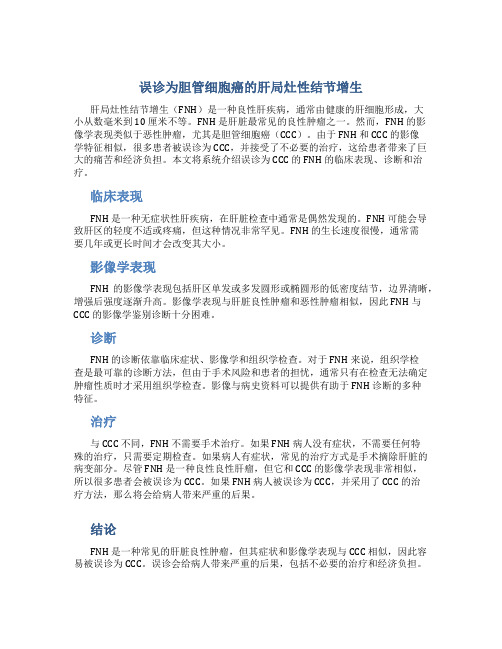
误诊为胆管细胞癌的肝局灶性结节增生肝局灶性结节增生(FNH)是一种良性肝疾病,通常由健康的肝细胞形成,大小从数毫米到 10 厘米不等。
FNH 是肝脏最常见的良性肿瘤之一。
然而,FNH 的影像学表现类似于恶性肿瘤,尤其是胆管细胞癌(CCC)。
由于 FNH 和 CCC 的影像学特征相似,很多患者被误诊为 CCC,并接受了不必要的治疗,这给患者带来了巨大的痛苦和经济负担。
本文将系统介绍误诊为 CCC 的 FNH 的临床表现、诊断和治疗。
临床表现FNH 是一种无症状性肝疾病,在肝脏检查中通常是偶然发现的。
FNH 可能会导致肝区的轻度不适或疼痛,但这种情况非常罕见。
FNH 的生长速度很慢,通常需要几年或更长时间才会改变其大小。
影像学表现FNH 的影像学表现包括肝区单发或多发圆形或椭圆形的低密度结节,边界清晰,增强后强度逐渐升高。
影像学表现与肝脏良性肿瘤和恶性肿瘤相似,因此 FNH 与CCC 的影像学鉴别诊断十分困难。
诊断FNH 的诊断依靠临床症状、影像学和组织学检查。
对于 FNH 来说,组织学检查是最可靠的诊断方法,但由于手术风险和患者的担忧,通常只有在检查无法确定肿瘤性质时才采用组织学检查。
影像与病史资料可以提供有助于 FNH 诊断的多种特征。
治疗与 CCC 不同,FNH 不需要手术治疗。
如果 FNH 病人没有症状,不需要任何特殊的治疗,只需要定期检查。
如果病人有症状,常见的治疗方式是手术摘除肝脏的病变部分。
尽管 FNH 是一种良性良性肝瘤,但它和 CCC 的影像学表现非常相似,所以很多患者会被误诊为 CCC。
如果 FNH 病人被误诊为 CCC,并采用了 CCC 的治疗方法,那么将会给病人带来严重的后果。
结论FNH 是一种常见的肝脏良性肿瘤,但其症状和影像学表现与 CCC 相似,因此容易被误诊为 CCC。
误诊会给病人带来严重的后果,包括不必要的治疗和经济负担。
因此,诊断医生需要准确诊断肝脏疾病,避免误诊。
- 1、下载文档前请自行甄别文档内容的完整性,平台不提供额外的编辑、内容补充、找答案等附加服务。
- 2、"仅部分预览"的文档,不可在线预览部分如存在完整性等问题,可反馈申请退款(可完整预览的文档不适用该条件!)。
- 3、如文档侵犯您的权益,请联系客服反馈,我们会尽快为您处理(人工客服工作时间:9:00-18:30)。
肝局灶性结节增生(FNH)【双语病例】 Focal nodular hyperplasia (FNH)病例选自《Mayo Clinic Body MRI Case Review》转自:双语学影像Fig 1.11.1Fig 1.11.2HISTORY:21-year-old woman with aliver mass identified incidentally on CT during workupfor acute appendicitis21岁女性,因阑尾炎行CT检查,发现肝脏肿块。
IMAGING FINDINGS:Axial fat-suppressed FSE T2-weighted image (Figure 1.11.1)demonstrates a large right hepatic lobe mass with mild hyperintensity relative to liver and a high intensity central scar. IP and OP T1-weighted 2D SPGR images showed no signal dropout to suggestintravoxel fat (images not shown). Pregadolinium and arterial, portalvenous, equilibrium, and 5-minute delayed phasepostgadolinium 3D SPGR images (Figure1.11.2) demonstrate marked,uniform arterial phase enhancement within the lesion that rapidly becomes isointensewith liver. Note also gradual enhancement of the central scar, as well as peripheral rim enhancement.横断位T2WI FSE脂肪抑制序列(Figure 1.11.1)示肝右叶巨大稍高信号肿块肿块,内可见中央瘢痕,呈明显高信号。
2D SPGR T1WI同反相位图像未见明显信号衰减,提示病灶内没有脂肪成分(图像未示出)。
3D SPGR增强扫描动脉期、门静脉期、平衡期及5分钟延迟扫描(Figure1.11.2)示动脉期明显均匀强化,然后信号迅速降低,门静脉期及平衡期病灶与肝实质呈等信号。
另外,中央瘢痕和病灶边缘呈渐进性强化。
DIAGNOSIS:Focal nodular hyperplasia局灶性结节增生COMMENT:FNH is the second most common benign tumor of the liver afterhemangiomas, accounting for 8% of these lesions and with an estimated prevalence of 0.9%。
FNHs consist of hyperplastic hepatocytes and small bile ductules surrounding a fibrovascular central scar that is thought to represent a hyperplastic response to a preexisting vascular malformation rather than a true neoplasm. They are more prevalent in women(usually of reproductive age) than men by an 8:1 ratio and are solitary in 80% to 95% of cases. Since FNHs are benign non-surgical lesions, the most important job of the imager is to make a confident diagnosisand distinguish them from more potentially unfriendly hypervascular lesions, such as adenoma, HCC, and metastases.Most of the time, this is relatively easy to accomplish.FNH是仅次于血管瘤的肝脏第二常见良性肿瘤,约占全部肝肿瘤的8%,发病率约为0.9%。
FNH主要由增生的肝细胞、小胆管包绕中心纤维血管瘢痕构成,一般认识是血管畸形基础上的增生性病变,而非真正的肿瘤。
FNH女性多于男性,男女比例约8:1,且通常发生于育龄妇女。
单发病灶多见,约占全部的80%-95%。
由于FNH是良性病变,不需要手术治疗,所以对于放射科医师来说,最主要的任务是明确诊断,与其他富血供潜在恶性肿瘤相鉴别,如腺瘤、HCC、转移瘤等。
通常FNH的诊断和鉴别诊断并不难。
Classic FNHs (illustrated by this case) are described as invisible or barely perceptible lesions except on postgadolinium arterial phase images; they are typically isointense to liver on T1-weighted images and isointense or mildly hyperintense on T2-weighted images. It is true, however, that FNHs are often at least moderately hyperintense on diffusion-weighted images, which illustrates the general principle that DWI is a technique better used for lesion detection than lesion characterization.Dynamic postgadolinium images show intense uniform enhancementon arterial phase images, which quickly becomes nearly isointense to liver on portal venous and equilibrium phaseimages. The central scar (seen in this case but not universally identifiable) generally shows high signal intensity on T2-weighted images and gradual enhancement following gadolinium administration. An elaborate set of imaging characteristics of the central scar has been described in the literature as a means of distinguishing FNH from fibrolamellar hepatoma; however, the percentage of lesions thatdon’t follow the rules is high enough that we rarely find these guidelines particularly useful.典型的FNH(如本例患者)在T1WI呈等信号,T2WI呈等或稍高信号,所以除了增强扫描动脉期外,有时难以发现。
然而在DWI图像上,病灶通常呈高信号,说明DWI在病灶的发现上作用大于定性诊断。
动态增强扫描,动脉期病灶明显强化,门脉期及延迟期病灶与肝实质呈等信号。
病灶中央瘢痕(本例患者可见,但并非全部可见)常呈T2WI 高信号,增强扫描渐进性强化。
中央瘢痕的这种典型表现通常作为FNH与纤维板层样肝癌的鉴别点,但很多的病例的表现并不如此典型,所以这一原则并非特别实用。
This case illustrates the appearance of a very large, but otherwise typical, FNH,obtained with a standard extracellular gadolinium-based contrast agent. The examination was done several years ago and exemplifies one of the problems of advancing technology: We read this case as consistent with FNH and offered no differential diagnosis. If it were to appear today,however, the report likely would containa differential that included adenoma (the hedge isthe radiologist’sfavorite plant) and suggest that a follow-up examination with a hepatobiliarycontrast agent be performed (although the absolutely classic appearance of the central scar might provide enough assurance for bold radiologists to remain firm in their conviction). This is entirely unnecessary; we used to be very certain about what FNH looked like usingstandard extracellular gadolinium contrast agents and were rarely mistaken. Although it is true that small adenomas can have a nearly identical appearance to FNH, they aren’t verycommon and it’s not clear whether missing one of these lesions results in any actual harm.此例患者病灶体积较大,但细胞外造影剂增强扫描图像非常典型。
